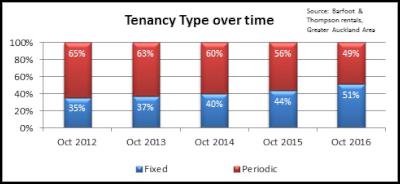Fixed-term tenancies surpass periodic for the first time
November 30, 2016
Media
statement
Fixed-term tenancies surpass periodic for the first time
Fixed-term tenancy agreements have surpassed periodic (open-ended) tenancies in popularity for the first time, accounting for 51% of tenancy agreements in 2016.
Barfoot & Thompson Director Kiri Barfoot says, “The increasing number of people living in rental properties as their home has sparked some debate about the terms and conditions of renting, particularly around security of tenure.
“There hasn’t been much data presented as part of this discussion. Our last five years of data show that fixed-term tenancies are increasing in popularity thus providing security for owners and tenants. In 2012, fixed-term agreements accounted for 35% of tenancies across our Auckland portfolio. In 2016, fixed-term tenancies have increased to 51% to become more popular than periodic.”
Currently, the most common fixed-term tenancies are 6-12 months in duration, followed by 12 months +, and less than 6 months.
Ms Barfoot adds, “In the past, when a fixed-term tenancy ended and the tenant and owner agreed to continue, ‘defaulting’ to periodic was common. Now people are opting to resign another fixed term.”
Barfoot & Thompson data also shows that duration of tenure is steady. Average tenancy duration in Auckland across all areas and property types as a whole has decreased slightly from 24.8 months in October 2012 to 23.6 months in October 2016.
Ms Barfoot explains, “Tenancy duration is influenced by a lot of factors. Tenancies tend to be shorter at around 17 months in the inner city where a high proportion of renters are students. And as reported last month, we’ve had a 36% increase in new apartments so the rental market is growing and evolving.
“The areas with the longest average tenancies tend to be the Central Suburbs at an average of 27 months and South Auckland at 26 months. Overall, one in ten renters has lived in their home for more than five years.
“The most stable suburbs – those with average tenancies over three years – include Balmoral, Lynfield, St Johns, Paerata (Pukekohe North), Mangere Bridge, Devonport and Green Bay. Unsurprisingly these suburbs are popular with families,” says Ms Barfoot.
“Landlords recognise tenants are looking for a place to call home. Security of tenure is just one element as a lot of people still want flexibility which comes with a periodic agreement. What’s most important is that tenant and landlord’s needs and expectations match. Security of tenure for those who want it is a great outcome.
“A good property manager can provide advice on the most suitable type of agreement for rental property owners. Their knowledge of the wider rental market trends, as well as access to a network of properties that comes with this benefits both tenants and owners,” says Ms Barfoot.
Fixed-term versus periodic tenancies over time:

The city’s most stable suburbs for rental tenure:
Balmoral, Lynfield, St Johns, Paerata, Mangere Bridge, Devonport and Green Bay.
Tenancy types in the simplest terms are as follows:
A periodic tenancy is one that continues until either the tenant or the landlord gives written notice to end it.
A fixed-term tenancy only lasts for a set amount of time - for example, one year. The amount of time must be written on the tenancy agreement.
A short fixed-term tenancy is one that lasts for 90 days or less, and these have their own special characteristics.
Ends


 Financial Markets Authority: Westpac Admits To Misleading Representations That Resulted In $6.35m In Overcharges
Financial Markets Authority: Westpac Admits To Misleading Representations That Resulted In $6.35m In Overcharges Bill Bennett: Download Weekly - Review Of 2024
Bill Bennett: Download Weekly - Review Of 2024 Bill Bennett: One NZ scores worldwide first as Starlink direct-to-mobile launches
Bill Bennett: One NZ scores worldwide first as Starlink direct-to-mobile launches Hugh Grant: How To Reduce Network Bottlenecks
Hugh Grant: How To Reduce Network Bottlenecks Dominion Road Business Association: Auckland Transport's 'Bus To The Mall' Campaign: A Misuse Of Public Funds And A Blow To Local Businesses
Dominion Road Business Association: Auckland Transport's 'Bus To The Mall' Campaign: A Misuse Of Public Funds And A Blow To Local Businesses Parrot Analytics: A Very Parrot Analytics Christmas, 2024 Edition
Parrot Analytics: A Very Parrot Analytics Christmas, 2024 Edition



